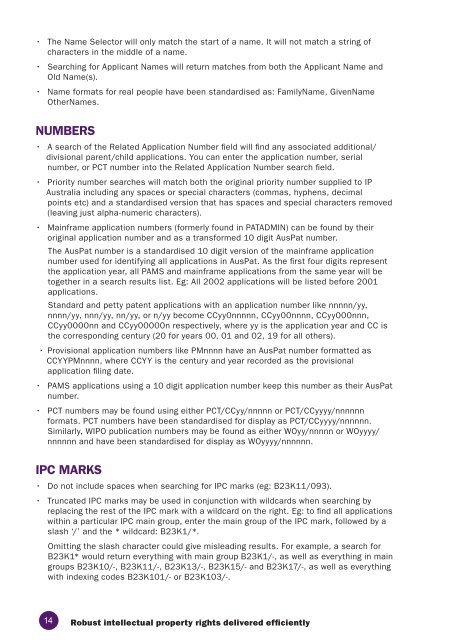AusPat User Guide - IP Australia
AusPat User Guide - IP Australia
AusPat User Guide - IP Australia
Create successful ePaper yourself
Turn your PDF publications into a flip-book with our unique Google optimized e-Paper software.
• The Name Selector will only match the start of a name. It will not match a string of<br />
characters in the middle of a name.<br />
• Searching for Applicant Names will return matches from both the Applicant Name and<br />
Old Name(s).<br />
• Name formats for real people have been standardised as: FamilyName, GivenName<br />
OtherNames.<br />
NUMBERS<br />
• A search of the Related Application Number field will find any associated additional/<br />
divisional parent/child applications. You can enter the application number, serial<br />
number, or PCT number into the Related Application Number search field.<br />
• Priority number searches will match both the original priority number supplied to <strong>IP</strong><br />
<strong>Australia</strong> including any spaces or special characters (commas, hyphens, decimal<br />
points etc) and a standardised version that has spaces and special characters removed<br />
(leaving just alpha-numeric characters).<br />
• Mainframe application numbers (formerly found in PATADMIN) can be found by their<br />
original application number and as a transformed 10 digit <strong>AusPat</strong> number.<br />
The <strong>AusPat</strong> number is a standardised 10 digit version of the mainframe application<br />
number used for identifying all applications in <strong>AusPat</strong>. As the first four digits represent<br />
the application year, all PAMS and mainframe applications from the same year will be<br />
together in a search results list. Eg: All 2002 applications will be listed before 2001<br />
applications.<br />
Standard and petty patent applications with an application number like nnnnn/yy,<br />
nnnn/yy, nnn/yy, nn/yy, or n/yy become CCyy0nnnnn, CCyy00nnnn, CCyy000nnn,<br />
CCyy0000nn and CCyy00000n respectively, where yy is the application year and CC is<br />
the corresponding century (20 for years 00, 01 and 02, 19 for all others).<br />
• Provisional application numbers like PMnnnn have an <strong>AusPat</strong> number formatted as<br />
CCYYPMnnnn, where CCYY is the century and year recorded as the provisional<br />
application filing date.<br />
• PAMS applications using a 10 digit application number keep this number as their <strong>AusPat</strong><br />
number.<br />
• PCT numbers may be found using either PCT/CCyy/nnnnn or PCT/CCyyyy/nnnnnn<br />
formats. PCT numbers have been standardised for display as PCT/CCyyyy/nnnnnn.<br />
Similarly, W<strong>IP</strong>O publication numbers may be found as either WOyy/nnnnn or WOyyyy/<br />
nnnnnn and have been standardised for display as WOyyyy/nnnnnn.<br />
<strong>IP</strong>C MARKS<br />
• Do not include spaces when searching for <strong>IP</strong>C marks (eg: B23K11/093).<br />
• Truncated <strong>IP</strong>C marks may be used in conjunction with wildcards when searching by<br />
replacing the rest of the <strong>IP</strong>C mark with a wildcard on the right. Eg: to find all applications<br />
within a particular <strong>IP</strong>C main group, enter the main group of the <strong>IP</strong>C mark, followed by a<br />
slash ‘/’ and the * wildcard: B23K1/*.<br />
Omitting the slash character could give misleading results. For example, a search for<br />
B23K1* would return everything with main group B23K1/-, as well as everything in main<br />
groups B23K10/-, B23K11/-, B23K13/-, B23K15/- and B23K17/-, as well as everything<br />
with indexing codes B23K101/- or B23K103/-.<br />
14 Robust intellectual property rights delivered efficiently
















